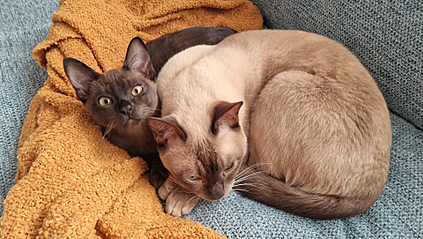Can I patent my cats?

… or any other living beings?
As a recent cat mom to two delightful felines (see above), I've naturally found myself pondering the best ways to ensure their protection and well-being. While patenting my cats isn't really a viable option (*spoiler alert*), this raises an intriguing question: what types of living beings can, and perhaps more crucially, cannot be patented?
Patentability Requirements in Europe
In Europe, for something to be patentable, it must be both new and inventive compared to everything that already exists or is known. Additionally, the patent application must describe the invention comprehensively and clearly enough for an expert to understand and reproduce it.
Plants and animals
Under Article 53(b) of the European Patent Convention (EPC), there are specific restrictions on the patentability of plants and animals. This article has a two-part exclusion:
- Plant or animal varieties: A single plant or animal variety is not patentable. For example, you couldn't patent a specific breed of cat like the "Burmese cat." However, a patent may be granted if the claims extend beyond a specific variety — for example, “a cat with gene X to produce medicinal products in their milk” could be patentable.
- Essentially biological processes: The EPC also excludes patents for plants or animals produced exclusively by natural processes like crossing or selection. Even if technical means are used to assist these processes, they are still unpatentable. However, a plant or animal produced through a technical process that modifies its genetic characteristics, like a transgenic organism, can be patented, provided it meets the general patentability requirements and is not limited to a specific variety.
The term exclusively, as used above, is to mean that a plant or animal originating from a technical process or characterized by a technical intervention in the genome is not covered by the exclusion from patentability even if in addition a non-technical method (crossing and selection) is applied in its production.
Transgenic plants or animals, and technically induced mutants, can be patented (if they are not confined to a specific animal or plant variety), while the products of conventional breeding cannot. It’s important to note that, for obvious reasons, animal varieties and any processes for modifying the genetic identity of animals which cause them suffering without substantial medical benefit are not patentable.
Microorganisms
Microorganisms are patentable in Europe, even if they haven’t been genetically modified. However, if the microorganism existed before, novelty would require it to be isolated from its natural environment.
The term “microorganisms” includes bacteria, plasmids, viruses, fungi, algae, and protozoa. Additionally, microbiological processes and their products are patentable if they meet the standard criteria of novelty and inventiveness.
Reproducibility of Living Matter
For living matter to be patentable, it must be possible to reproduce it in a way that has exactly the same technical features. This can be assured by:
- Depositing the living matter (seeds, microbiological strains). The deposited material must be publicly available and such that the invention can actually be reproduced starting from it (check out our blog post on Biological Deposits for patents in Europe)
- Disclosing in the application as filed the gene sequence responsible for the claimed trait together with instructions on how to reproducibly introduce by technical means such an altered sequence in a target organism (e.g. by CRISPR-Cas).
Humans and human embryos
Under Rule 28 EPC, European patents cannot be granted for biotechnological inventions related to:
- processes for cloning human beings;
- processes for modifying the germ line genetic identity of human beings; and
- uses of human embryos for industrial or commercial purposes.
Rule 29 EPC further specifies that the human body, at any stage of its formation or development, along with the mere discovery of one of its elements (including the sequence or partial sequence of a gene), cannot be patented. However, elements isolated from the human body or produced by a technical process — such as a gene sequence — can be patented, even if their structure is identical to natural elements.
Likewise, while the use of human embryos for industrial or commercial purposes is excluded from patentability, inventions aimed at therapeutic or diagnostic purposes that benefit the embryo itself are not. However, human embryonic stem cells are unpatentable if their derivation requires the destruction of an embryo.
So, Can I Patent My Cats?
Unfortunately, unless I’ve modified the genetics of my two feline beauties — which, of course, I wouldn’t, as they’re already perfect — patenting them is off the table.
Do you have a question?
We would be happy to assist you.
Make an appointment with one of our experts.
Rest assured, you're not alone.
Feel free to browse through the FAQ and don't hesitate to
contact us if you still have any doubts.




